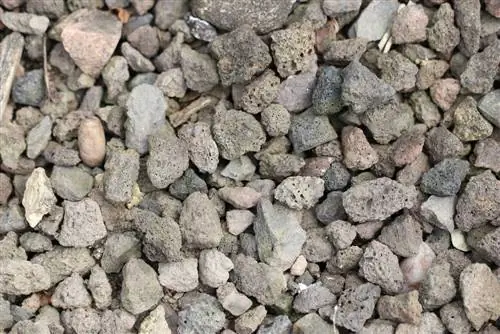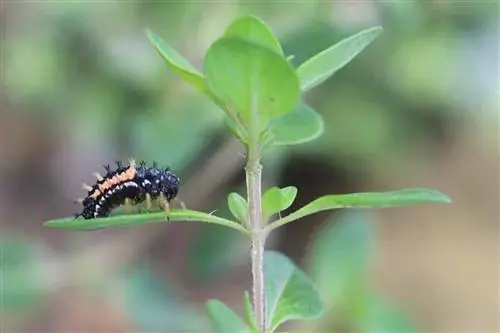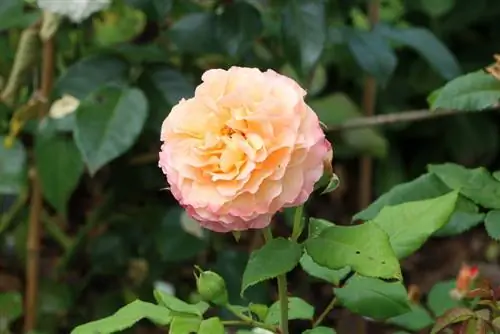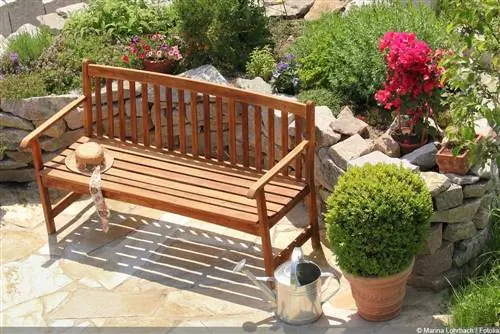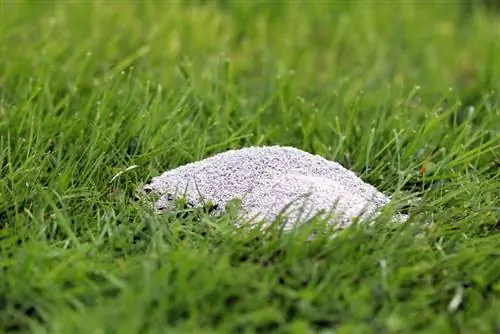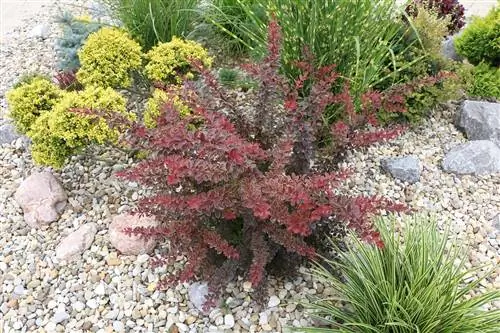- Author admin [email protected].
- Public 2023-12-17 03:39.
- Last modified 2025-01-24 12:45.
Using lava stones in the garden offers several advantages both when planting outdoors and when growing in containers - if the natural granules are used correctly. This depends on the grain size as well as the correct mixture with the substrate. It is also important to know the properties of the lava granules in order to be able to use them specifically.
Oxygen
Lava stones are porous and light. These properties loosen the soil and increase the oxygen content. They also ensure improved water drainage, especially in heavy and clayey soils. This reduces the risk of waterlogging.
Water storage
Lava granules store water and slowly release it again. This results in two advantages. On the one hand, excess liquid is absorbed from the substrate, which in turn prevents the risk of waterlogging. On the other hand, the stored liquid is released again when the earth becomes drier. In this way, the substrate is prevented from drying out for longer and the amount of watering is reduced. In addition, the soil is stabilized by the continuous moistening and is therefore not washed away so easily.
Ground heat
Apart from water, lava stones also store heat and gradually release it again. On the one hand, this avoids abrupt temperature fluctuations. On the other hand, cold-sensitive plants receive a certain amount of protection from the lava granules. In order to use this property or to use it specifically, the lava stones can be mixed into the substrate or applied as a layer to the surface.
Weed protection
Lava granules also serve as weed protection when applied to the soil about two centimeters thick. Not only does it reduce the drying out of the soil and store heat, but it can also prevent the growth of unwanted and competing plants.
Decoration
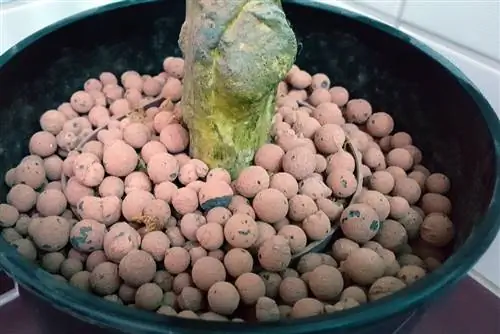
Lava stones are not only available in different sizes, but also in different colors. This allows different areas in the garden to be demarcated or color accents to be set.
Tip:
Colored lava granules should not be used in garden ponds.
Size
Lava stones are available in different sizes, which means they can be selected to suit their intended purpose. Recommended are:
- Lava granules measuring two to four millimeters are suitable for aquariums
- Lava granules measuring two to eight millimeters are suitable for garden ponds
- Eight to 16 millimeter lava stones can be used to mix with substrate
All sizes from two to 16 millimeters can be used as covering mulch on the ground.
Mixing ratio
If you want to mix the substrate with lava granules, you should aim for a ratio of 4:1 - i.e. four parts earth and one part lava stones. So that the granules can be distributed evenly in the soil, it is recommended to first mix the earth and stones together in a separate container. The mixing ratio can be varied depending on the nature of the soil and the care requirements of the plant. Plants that require a very loose and permeable substrate benefit from a ratio of 3:1. If the soil is a little denser, you can add one part of lava granules to five parts of soil. The effort involved in both mixing and mulching is very small. Since the lava stones do not disintegrate, the measure only has to be carried out once.
Be careful with root contact
As practical as the lava granules are, they should not have direct contact with roots. There are three reasons for this. On the one hand, it supplies the roots with moisture, but makes it more difficult for them to absorb nutrients. The sole reason for this is that it increases the distance to the substrate. On the other hand, it increases the oxygen content directly at the roots too much. Many plants are weakened as a result, their growth decreases and their resistance decreases. Another problem is the fine dust that lava stones can emit if they are not rinsed thoroughly before use. This can also prevent the roots from absorbing nutrients and water from the substrate. The described mixture of soil and granules is therefore better in order to prevent too much contact between the roots and the lava stones. This should be taken into account especially when repotting potted plants.
Drainage
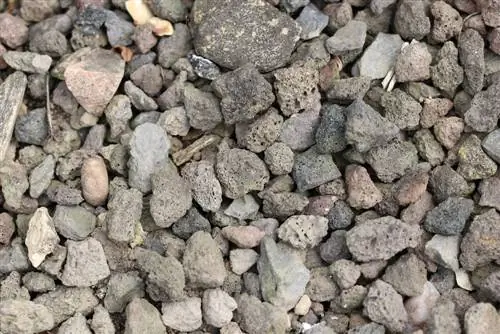
The lava granules are used as mulch on the ground, are suitable for mixing with the substrate and can also be used as a drainage layer in planters. For this purpose, the largest possible grain size should be used. The use is again very simple - the lava stones are simply placed on the bottom of the bucket in a two to four centimeter thick layer. They store excess water and release it gradually. At the same time, they provide a loose barrier between the substrate and the roots and any standing water in the planter or saucer.
Tip:
If the bucket has very large drainage holes, you should first loosely place clay shards over these and only then fill in the lava granules. This will prevent the small stones from trickling out of the planter.
Garden pond
The lava granules can not only be used in the garden to improve the soil and for the plants, but can also serve well in the garden pond. Here it serves as a kind of natural filter medium. Due to its porous nature, it has a very large surface area. This allows numerous beneficial bacteria and microorganisms to settle in the lava stones. These in turn help to break down excess nutrients and harmful substances in the water and thus maintain a he althy balance in the pond. This reduces the risk of the water “tipping over”. During this development, too many nutrients accumulate in the water, which reduces the oxygen content. This worsens the conditions for aquatic plants and aquatic life.
The lava granules can be used in the garden pond as follows:
- as medium in the filter
- as substrate
- as a substrate or admixture in the substrate of the aquatic plants used
So that the useful bacteria are not killed when cleaning the pond, but can ensure good water quality again, the stones should only be rinsed with cool water. Hot water should not be used.
Tip:
Colored lava granules should not be used for the garden pond. The stones should also be rinsed thoroughly and soaked until the water remains clear - before being placed in the pond.

